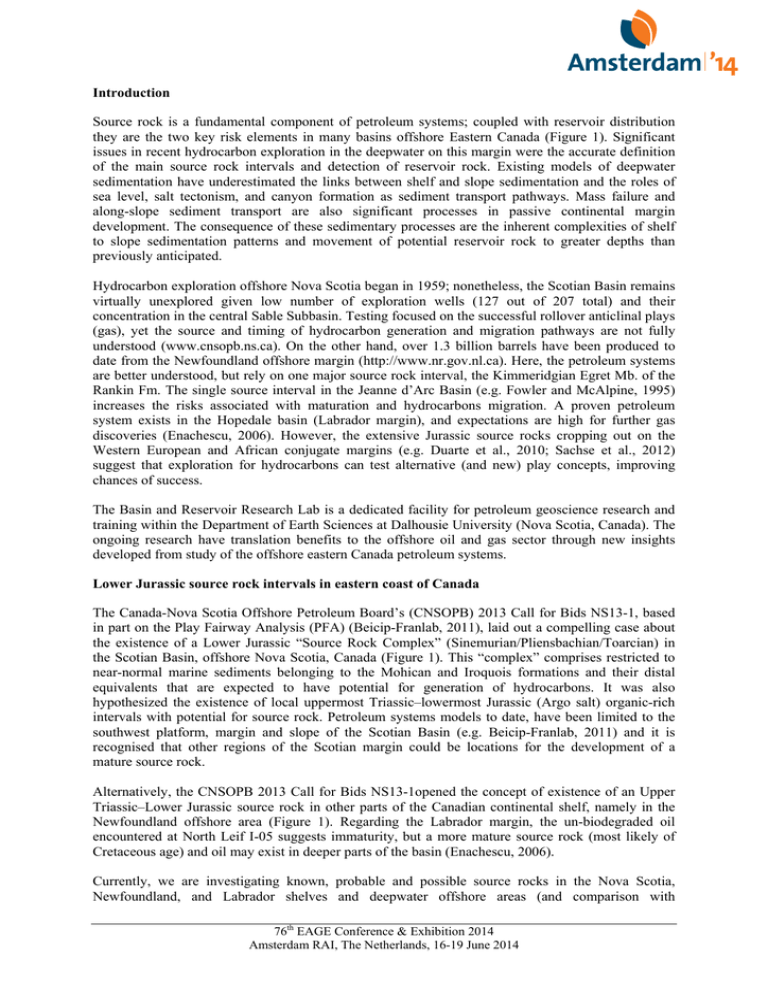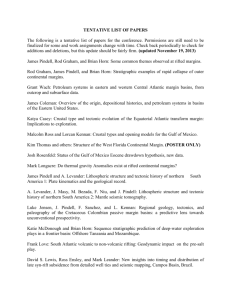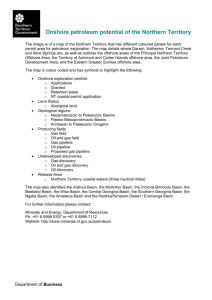Introduction Source rock is a fundamental component of petroleum
advertisement

Introduction Source rock is a fundamental component of petroleum systems; coupled with reservoir distribution they are the two key risk elements in many basins offshore Eastern Canada (Figure 1). Significant issues in recent hydrocarbon exploration in the deepwater on this margin were the accurate definition of the main source rock intervals and detection of reservoir rock. Existing models of deepwater sedimentation have underestimated the links between shelf and slope sedimentation and the roles of sea level, salt tectonism, and canyon formation as sediment transport pathways. Mass failure and along-slope sediment transport are also significant processes in passive continental margin development. The consequence of these sedimentary processes are the inherent complexities of shelf to slope sedimentation patterns and movement of potential reservoir rock to greater depths than previously anticipated. Hydrocarbon exploration offshore Nova Scotia began in 1959; nonetheless, the Scotian Basin remains virtually unexplored given low number of exploration wells (127 out of 207 total) and their concentration in the central Sable Subbasin. Testing focused on the successful rollover anticlinal plays (gas), yet the source and timing of hydrocarbon generation and migration pathways are not fully understood (www.cnsopb.ns.ca). On the other hand, over 1.3 billion barrels have been produced to date from the Newfoundland offshore margin (http://www.nr.gov.nl.ca). Here, the petroleum systems are better understood, but rely on one major source rock interval, the Kimmeridgian Egret Mb. of the Rankin Fm. The single source interval in the Jeanne d’Arc Basin (e.g. Fowler and McAlpine, 1995) increases the risks associated with maturation and hydrocarbons migration. A proven petroleum system exists in the Hopedale basin (Labrador margin), and expectations are high for further gas discoveries (Enachescu, 2006). However, the extensive Jurassic source rocks cropping out on the Western European and African conjugate margins (e.g. Duarte et al., 2010; Sachse et al., 2012) suggest that exploration for hydrocarbons can test alternative (and new) play concepts, improving chances of success. The Basin and Reservoir Research Lab is a dedicated facility for petroleum geoscience research and training within the Department of Earth Sciences at Dalhousie University (Nova Scotia, Canada). The ongoing research have translation benefits to the offshore oil and gas sector through new insights developed from study of the offshore eastern Canada petroleum systems. Lower Jurassic source rock intervals in eastern coast of Canada The Canada-Nova Scotia Offshore Petroleum Board’s (CNSOPB) 2013 Call for Bids NS13-1, based in part on the Play Fairway Analysis (PFA) (Beicip-Franlab, 2011), laid out a compelling case about the existence of a Lower Jurassic “Source Rock Complex” (Sinemurian/Pliensbachian/Toarcian) in the Scotian Basin, offshore Nova Scotia, Canada (Figure 1). This “complex” comprises restricted to near-normal marine sediments belonging to the Mohican and Iroquois formations and their distal equivalents that are expected to have potential for generation of hydrocarbons. It was also hypothesized the existence of local uppermost Triassic–lowermost Jurassic (Argo salt) organic-rich intervals with potential for source rock. Petroleum systems models to date, have been limited to the southwest platform, margin and slope of the Scotian Basin (e.g. Beicip-Franlab, 2011) and it is recognised that other regions of the Scotian margin could be locations for the development of a mature source rock. Alternatively, the CNSOPB 2013 Call for Bids NS13-1opened the concept of existence of an Upper Triassic–Lower Jurassic source rock in other parts of the Canadian continental shelf, namely in the Newfoundland offshore area (Figure 1). Regarding the Labrador margin, the un-biodegraded oil encountered at North Leif I-05 suggests immaturity, but a more mature source rock (most likely of Cretaceous age) and oil may exist in deeper parts of the basin (Enachescu, 2006). Currently, we are investigating known, probable and possible source rocks in the Nova Scotia, Newfoundland, and Labrador shelves and deepwater offshore areas (and comparison with 76th EAGE Conference & Exhibition 2014 Amsterdam RAI, The Netherlands, 16-19 June 2014 contemporaneous analogues). The research is focused in the Triassic–Jurassic time interval, and is supported by an evaluation and reanalysis of the existing and available organic geochemistry datasets, observation and geochemical study of selected cores, cuttings and integration with time-equivalent source rock outcrops and well data in Canada and associated conjugate margins, namely Morocco, Portugal, Spain, UK and Ireland (e.g. Silva et al., 2014). Figure 1 Sedimentary basins formed by the rifting and seafloor spreading that began in the Late Triassic, leading to the opening of the Atlantic Ocean (modified from Tankard and Balkwill, 1989; Decourt et al., 2000, among others). Overpressure, Seal Integrity, and Reservoir Connectivity in the Scotian Basin Overpressure is abnormally high subsurface pressure that exceeds hydrostatic pressure at a given depth, and occurs when connate fluids are unable to escape the surrounding mineral matrix. Difficulty managing abnormal pressures during drilling is frequently cited for abandoning wells or for unexpected, expensive changes in the casing program. The causes of overpressure in the Scotian Basin are poorly understood, and with the recent increase in exploration for hydrocarbons offshore Nova Scotia, understanding the development of overpressure is important for maximizing safety, production, and developing new opportunities. The reservoir connectivity analysis is important to understanding the overpressure systems of the Scotian Basin, and includes: reservoir architecture, definition of seal integrity, and determination connectedness of compartments (Dickson and Wach, 2013). The use of analogous basins with similar formation and depositional histories is essential, as data are limited from the Scotian Basin. These basins on the Atlantic conjugate margin include Jeanne d’Arc Basin, Porcupine Basin, and Northern North Sea Basin. The Eastern Venezuelan Basin is valuable as a depositional analogue in addition to providing insight into active overpressure regimes. Overpressure is a serious risk element in all of these basins including the Scotian Basin, and needs to be understood to safely develop and produce offshore resources. 76th EAGE Conference & Exhibition 2014 Amsterdam RAI, The Netherlands, 16-19 June 2014 Figure 2 Petroleum systems chart of the Scotian Basin (after Wade and MacLean, 1990). Carbonate and Siliciclastic Petroleum Systems Contemporaneous siliciclastic and carbonate depositional systems began in the Upper Jurassic, with a progradational ramp with platform margin reefs and continued to the middle Cretaceous. Deltaic and shelf margin deltas have been interpreted for several of the Sable Sub-basin gas fields (Cummings and Arnott 2005). The paleo-shelf edge is of economic interest for both sandstone and carbonate reservoirs with the discovery of the Deep Panuke field in 1998, the only carbonate gas field in the eastern North America continental shelf producing from hydrothermally-dolomitized reef margin. Deep Panuke is placed in a larger context between the northeast contemporaneous major Sable paleodelta prograding ramp shelf and the southwest thicker cleaner carbonate platform. The facies trends relative to the Sable delta and the associated early, deep prodeltaic burial are key factors that contributed to Deep Panuke’s possibly unique hydrocarbon system of reservoir, trap, seal and charge properties (Eliuk and Wach, 2008; Eliuk, 2010). Conclusions Research in the Basin and Reservoir Lab of the Dalhousie University focus on petroleum system and risk elements analysis on the Nova Scotia, Newfoundland, and Labrador shelves and deepwater offshore. Research includes the observation and geochemical study of selected cores to improve source rock understanding, reservoir outcrop analogs, overpressure and integration of these data with time-equivalent sedimentary series in eastern Canada and associated conjugate margins (Morocco, 76th EAGE Conference & Exhibition 2014 Amsterdam RAI, The Netherlands, 16-19 June 2014 Portugal, Spain, UK and Ireland). The extensive source rocks and reservoir analogs cropping out on the Western European and African conjugate margins suggest that exploration for hydrocarbons can test alternative (and new) play concepts, improving chances of success. References BEICIP-FRANLAB [2011] Play Fairway Analysis (PFA) offshore Nova Scotia Canada. Published report. http://www.novascotiaoffshore.com/analysis. Cummings, D.I. and Arnott, R.W.C. [2005] Growth-faulted shelf-margin deltas: a new (but old) play type, offshore Nova Scotia. Bulletin of Canadian Petroleum Geology, 53, 211-236. Dercourt, J., Gaetani, M., Vrielinck, B., Barriers, E., Biju-Duval, B., Bruner, M.F., Cadet, J.P., Crasquin S. and Sandulescu, M. (eds.) [2000] Atlas Peri-Tethys, Palaeogeographical Maps. CCGM/CGMW, Paris. Dickson, C. and Wach, G. [2013] Overpressure Conditions and Reservoir Compartmentalization on the Scotian Margin – Study Overview. GeoConvention 2013: Integration, Calgary. Duarte, L.V., Silva, R.L., Oliveira, L.C.V., Comas-Rengifo, M.J. and Silva, F. [2010] Organic-rich facies in the Sinemurian and Pliensbachian of the Lusitanian Basin, Portugal: Total Organic Carbon distribution and relation to transgressive-regressive facies cycles. Geologica Acta, 8, 325-340. Enachescu, M.E [2006] Atlantic off Labrador poised for modern exploration round. Oil and Gas Journal, 104, 36-42. Eliuk, L. [2010] Regional Setting of the Late Jurassic Deep Panuke Field, Offshore Nova Scotia, Canada – Cuttings Based Sequence Stratigraphy and Depositional Facies Associations - Abenaki Formation Carbonate Margin. AAPG Convention 2010, Search and Discovery Article #10259 (abstract). Eliuk, L. and Wach, G.D. [2008] Carbonate and siliciclastic sequence stratigraphy – examples from the Late Jurassic Abenaki limestone and West Venture deltaic beds, offshore Nova Scotia, Canada. In; Brown, D.E., ed., Program & Extended abstracts Central Atlantic Conjugate Margin Conference, ISBN: 0-9810595-1; CD and website, 410-437. Fowler, M.G. and McAlpine, K.D. [1995] The Egret Member, a Prolific Kimmeridgian Source Rock from Offshore Eastern Canada. In: Katz, B. (Ed.) Petroleum Source Rocks, Casebooks in Earth Sciences. Springer-Verlag, 111-130. Sachse, V.F., Leythaeuser, D., Grobe, A., Rachidi, M. and Littke, R. [2012] Organic geochemistry and petrology of a Lower Jurassic (Pliensbachian) petroleum source rock from Aȉt Moussa, Middle Atlas, Morocco. Journal Petroleum Geology, 35(1), 5-24. Silva, R.L., Wach, G. and Wong, C. [2014]. Spectral gamma-ray evaluation of Lower Jurassic basalts and lacustrine sediments from the Fundy Basin (Nova Scotia, Canada). EGU General Assembly 2014, Geophysical Research Abstracts, 16, EGU2014-1559. Tankard, A.J. and Balkwill, H.R. [1989] Extensional Tectonics, Structural Styles and Stratigraphy of the North Atlantic Margins: Introduction”. In: Tankard, A.J. and Balkwill, H.R. (Eds) Extensional Tectonics and Stratigraphy of the North Atlantic Margins. AAPG Memoir, 46, 1-6. Wade, J.A. and MacLean, B.C. [1990] The geology of the southeastern margin of Canada. Geology of the continental margin of eastern Canada. Geological Survey of Canada, Geology of Canada, 2, 167238. 76th EAGE Conference & Exhibition 2014 Amsterdam RAI, The Netherlands, 16-19 June 2014





